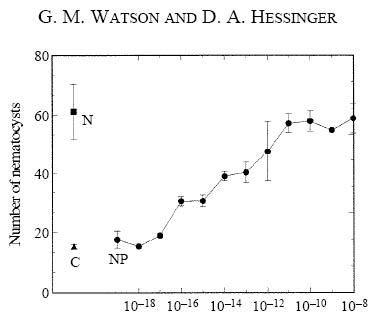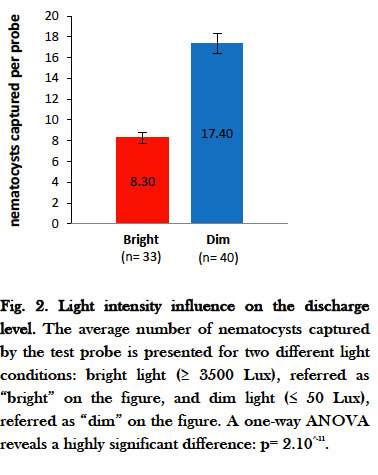Difference between revisions of "The Data Dump Paper"
From Ucsbgalaxy
(→Bright Light inhibits firing rate in 3 cnidarian species) |
(→Bright Light inhibits firing rate in 3 cnidarian species) |
||
| Line 35: | Line 35: | ||
====''Haliplanella''==== | ====''Haliplanella''==== | ||
[[File:Katia_light_results.jpg]] | [[File:Katia_light_results.jpg]] | ||
| − | ==== | + | ====''Anthopleura''==== |
[[Gold's Anthopleura data]] | [[Gold's Anthopleura data]] | ||
| − | ==== | + | ====''Aurelia''==== |
[[Fong's Aurelia data]] | [[Fong's Aurelia data]] | ||
Revision as of 16:27, 23 November 2011
Title
Abstract
Introduction
Question 1 - Is Light Modulation Ancestral in Cnidaria?
- Previous research indicates light modulates nematocyte firing in hydra. See Plachetzki nematocyte firing.
- Do cnidarians from other classes show a similar response to light, with respect to the modulation of nematocyte firing?
- In addition to the hydrozoan hydra, we tested light modulation of nematocyte firing in one scyphozoan (Aureila), and two anthozoans (Anthopleura and Haliplanella).
Question 2 - Why Light modulation?
H1: Pleiotropy
Molecular components are shared between chemo- and photo-reception. Do opsins artifactually affect the chemo-transduction cascade?
- Background
- Known cnidarian phototransduction systems use G-alpha-s, which may stimulate adenylyl cyclase (AC) to decrease cAMP,
- In Haliplanella, NANA may signal an unknown receptor that activates G-alpha-s, which may stimulate AC to decrease cAMP, which lengthens hair bundles to tune nematocyte firing to lower frequency vibrations. Note that Watson and Hessinger [1] distinguish between Contact Sensitive (CSM) and Vibration Sensitive Mechanoreceptors VSMs). Our protocols should mainly stimulate CSMs.
- Watson and Hessinger proposed that proline acts in opposition to NANA, and its receptor signals through G-alpha-i to shorten hair bundles and tune firing to higher frequency vibrations.
- Katia tested effects of light and mucin together on nematocyte firing.
- Federico tested whether light sensitivity involves G-alpha-i by using Pertussis toxin
H2: Light cues signal reliability of different feeding modes
- Bright light could favor transition to relying on photosynthetic symbionts.
- Dim light could signal nightfall, when zooplankton prey are more active
Methods
Results
Bright Light inhibits firing rate in 3 cnidarian species
Haliplanella
Anthopleura
Aurelia
Influence of Ptx (Gi inhibitor) in the presence of NANA and Proline
- In bright light (and Nana-proline), the Gi inhibitor Ptx seems to have no effect (could formally test that slope of Ptx concentration and firing rate is NSD than zero)
- In dim light (and Nana-proline), the Gi inhibitor Ptx affects firing rate. More ptx yields less firing. This is consistent with Watson's results above, where light intensity was not specified (it was probably not as bright as our 3500 lux trial). Watson suggested that proline inhibits firing through Gi. This does not explain how proline increases firing compared to ASW alone, as Fede found, and Watson himself found for


